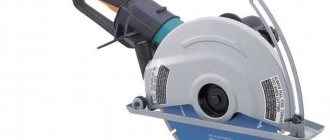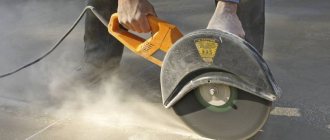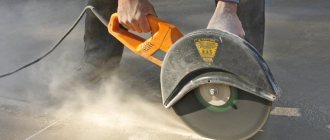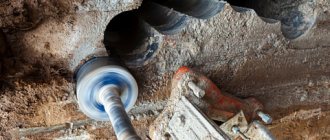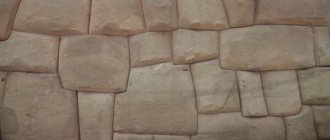Cutting concrete without dust is practically impossible, since in the process of sawing and processing stone one way or another a lot of dust appears, the volume of which can only be reduced. But it is also advisable to do this, since too much dust during the work process causes many troubles: it spoils the tool and dulls the parts, settles in the lungs and on all surfaces in the room.
With the use of modern equipment, sawing concrete has become easier - there are special cutting tools and consumables for them. The devices can be manual or stationary, powered by electricity or other sources. As a rule, all tools for cutting concrete are equipped with diamond parts - chains, discs, crowns, brazed tips, etc.
Diamond cutting technology for concrete: subtleties
Diamond is the hardest material known to mankind. When they learned to make artificial minerals in the middle of the last century, the era of heavy-duty tools for drilling, cutting and processing metal rods, reinforced concrete, monoliths, and blocks began.
The working surface of the cutting tool is covered with segments of non-natural diamonds. Using the galvanic method, sintering or pressing, they are applied to replaceable discs, crowns, as well as special chains and edges - these are equipment attachments and consumables.
The service life and performance of tools depend on the concentration of diamond dust on the nozzles and the methods of its attachment to the surface.
Diamond cutting of concrete - a gentle operation with a minimum of dust and vibration - is carried out in two ways:
- Dry cutting. It is used when there is no access to water or there is a high probability of flooding the lower floors or damaging the floor covering in the room being repaired. When dry cutting, the tool becomes very hot and wears out intensively - the diamond coating can peel off from the metal surface. Short (1.5-2.0 minutes) cuts at intervals to cool the attachments with air prevent overheating of the cutting edges. Dry cutting generates some dust, so the method is not used in enclosed spaces.
- Wet cutting. The technology is the same, but water is periodically or constantly supplied to the instrument for cooling. This method is preferable because it does not generate dust - it is absorbed by the liquid (scrubber principle). The cutting speed increases, the operator works more accurately, and cuts and cuts are performed with better quality. Another advantage is that the working life of consumables is saved.
The method is chosen based on the working conditions: is there a constant source of electricity and water, the ability to remove sludge and liquid with industrial vacuum cleaners, how many people can be involved in the process.
Scope of application of diamond cutting
Wall sawing machines are widely used in repair and construction. Wall cutting without dust, vibration and debris is carried out when necessary:
- prepare holes for sewer, water and heating pipes;
- lay air ducts and ventilation shafts in the load-bearing walls;
- punch technical holes in the foundations;
- cut window and door openings;
- drill holes for installing railings and fences.
Diamond cutting of reinforced concrete is necessary when niches are cut out in a house for built-in furniture and safes, or walls are dismantled to remodel an apartment. Installations with diamond tips are required in private and industrial construction at any stage.
How to make a casing for a vacuum cleaner with your own hands
An angle grinder with a built-in vacuum cleaner allows you to get rid of small particles of material formed during the cutting process with an angle grinder. But what if there is a need to cut concrete with a conventional tool without additional options? The simplest solution would be to purchase a casing for the vacuum cleaner separately or to make the device yourself. You can hire an assistant who will collect the particles formed during cutting with a vacuum cleaner.
You can easily make a convenient nozzle from a simple plastic canister, in which car “anti-freeze” is often sold. To work, you will need a construction cutter and a container of a suitable size, the neck of which will fit the diameter of the vacuum cleaner hose.
The manufacturing sequence is as follows:
- Mounting holes are cut on both sides so that you can easily change the direction of rotation of the disk.
- A slot of suitable size is made under the circle.
- To attach the grinder cutter, another hole is cut.
- The hose is connected to the neck of the canister and secured with an adapter ring with a clamp.
- The “grinder” is placed in the casing and all the elements are connected.
- The unused hole is covered with a lid.
A good dust collector can be made from a simple five-liter plastic bottle. It is attached using a standard protective casing, and the vacuum cleaner pipe is attached to the neck. This design is suitable for any type of work, with the exception of gating.
Last tip: in order to make a straight cut, markings are first applied. Then wooden blocks are fixed along the line. After this, a shallow incision of up to 1 cm is made, the restraints are removed and work continues. Throughout the entire process, coolant is supplied to the disc blade. All manipulations must be carried out wearing protective glasses, a respirator and gloves.
Equipment for cutting reinforced concrete
Cutting openings in concrete is not for amateurs. The installations are operated by trained and appropriately authorized operators. New machines replaced jackhammers, hammer drills, and sledgehammers.
Seam cutters
This construction equipment is called a joint cutter. They are used when you need to make a deep narrow channel in asphalt, concrete, stone, or paving slabs. Thin, neat seams without torn edges are needed for laying communications.
The car looks like a steel frame on wheels and with a motor. A large diamond-coated disk is connected to the motor. The device is rolled over the surface, the disk cuts into the material and makes a groove. If necessary, the cutting part is deepened.
A marker is attached in front of the cutter, which allows the tool to move strictly along the drawn line. A water tank is provided to cool the nozzle. Installation weight – up to 100 kg.
Wall sawing machines
This is a large-sized electric machine, which consists of a housing, a protective casing, a motor, and a guide plate. The design also includes: a gearbox with a rack and pinion transmission and a shaft on which a diamond disk is mounted. The housing can be made in a movable or rotating version. The device operates on a voltage of 380V.
It is irrational to use such an installation for small areas. The area to be processed must be at least a square meter, otherwise cutting walls with such serious equipment will be economically unprofitable.
Unlike an impact drill, the machine does not shake walls or make noise. Dirt is removed with water.
Drilling rigs
Machines for diamond (core) drilling of concrete are professional construction equipment. The machine drills holes of exactly the specified size using crowns of various diameters. The tool is intended for laying pipes, wires, risers. A fragment of the drilled wall is simply removed from the hole.
Filigree work is ensured by a frame with guides and an electric motor with a power of at least 2 kW. The diamond bit receives rotation from the spindle through the shaft (shank).
Rope machines
When you need to cut through a concrete block more than 1 meter thick, a circular saw is powerless. An effective technology using diamond wire has been invented.
Holes are drilled in the wall, a steel cable is inserted into them, and it is closed through pulleys. An essential component of the machine is a powerful power unit. It rotates and causes the rope to slide. At this moment, the diamond segments of the cable cut into the material and gradually saw through it - the opening is ready. Cool the cutting part with water.
Hand carvers
The usual name for such tools for cutting concrete walls is “grinder”. However, in professional language it is an angle grinder (angle grinder). Tools of varying power are equipped with special attachments that are attached to the cutter with a screw connection.
The kits include grinding, cutting and roughening discs. The equipment copes with concrete and brick walls up to 13 cm thick.
There is no need for special training - any adult can work as a grinder. The maneuverable hand tool processes large areas in a short time.
Regulated sequence of work
The dismantling performed by diamond cutting creates a prerequisite for the operator - the presence of genuine competence and professional experience. Traditionally, cutting a surface requires preventive actions: preparation with the creation of markings. The specialist plans the work in such a way as to avoid (reduce the probability to a minimum) destruction of structures or general danger.
The next step will be the formation of holes that are located in the corners of the opening. Before cutting begins, ensure an uninterrupted flow of water to the cutting diamond blade. Contact of liquid with water cools the disk heated to high temperatures; Likewise, the possibility of dust formation is eliminated.
The incoming water removes the dust created - when walls are removed - as well as additional debris and flying particles. Reinforcement of openings, for example, is carried out after cutting is completed to ensure the safety of the operator and the integrity of the wall structure.
Reinforcement involves the use of metal components - reinforcing structures.
Diamond cutting of openings in load-bearing walls
The load-bearing wall supports the weight of the upper floors and roof. Without permission from housing and communal services, the architectural department, and management companies, it is prohibited to demolish or make openings in such structures. When consent is obtained, they work using the following methods.
Drilling
Through holes of various shapes are made using diamond drilling technology. They first draw up a diagram, clean the surface, and draw the outline of the future opening. Then holes are drilled along its perimeter with a drilling rig (the tool is held strictly perpendicular to the wall).
On the reverse side, already along the holes, draw the same outline and mark it with inserted disks. A piece of the wall is broken into fragments and cut out one by one. At the final stage, horizontal and vertical supports in the form of channels and corners are installed into the resulting opening.
Diamond drilling in concrete does not cause inconvenience to residents of apartment buildings (squealing tools, shaking walls).
Cutting walls with a grinder
It is problematic to cut through a load-bearing wall with an angle grinder, even with diamond blades. Typically, this compact tool is used for “finishing” work on openings. When fragments are knocked out of a brick wall, uneven edges remain - they are trimmed with a grinder.
When cutting openings in load-bearing walls, an angle grinder is an auxiliary tool when a jackhammer or hammer drill is chosen as the main one.
Why are our prices low?
3. We would like to note several features that will be beneficial, first of all, to the customer due to the following points that help reduce tariffs for services provided: 1) We work without intermediaries, staff and managers who need to pay salaries and deduct interest. 2) We use our own professional tools, which means there is no need to spend money on renting expensive equipment. 3) We rationally use advertising techniques, using mainly the concept of “word of mouth”. Over 14 years of study, practice and fruitful work in the diamond technology market, we have managed to create a base of regular customers, 75% of whom recommend our services as high-quality work performed on time at reasonable prices.

